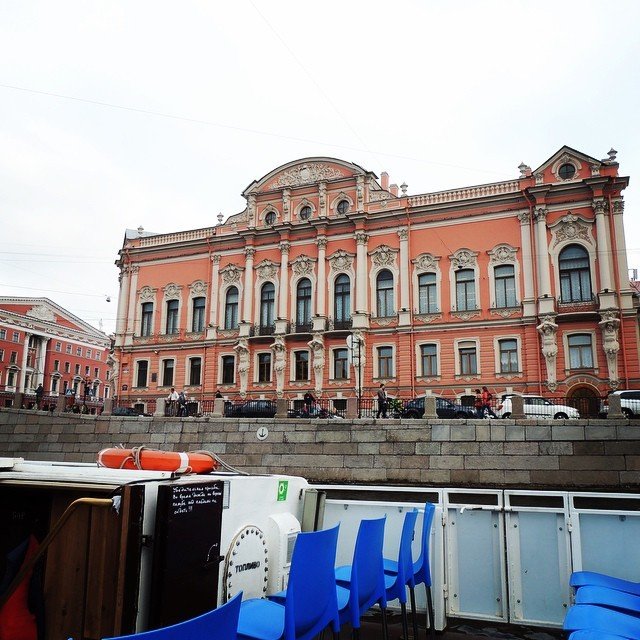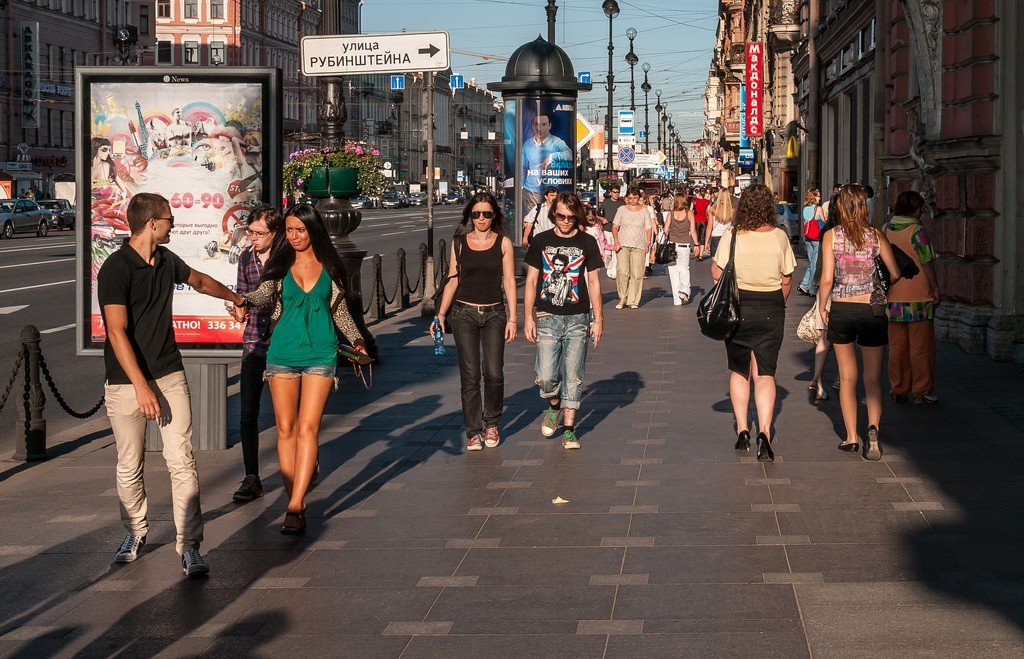Beloselskikh-Belozerskikh Palace
Beloselski-Belozersky Palace is not the last place in the list of historical sights of Nevsky Prospekt. This “pink castle” nevertheless has a special charm.










- History of construction
- The Beloselski-Belozersky Palace and its owners
- The palace today
- Interesting facts and myths, related to the palace
- Useful information
- How to get there
History of construction
At the end of the XVIII century, the corner of the Fontanka and Nevsky embankment was occupied by an ordinary, unremarkable house. In 1797, the fate of this ordinary building was decided by Princess A. G. Beloselskaya, who wanted to have her own palace. The plot, liked the titular person, was hastily bought, and the unpretentious structure was immediately demolished, erecting in its place the first modest version of the palace – a three-story mansion.
.
In the middle of the XIX century, the new owner of the estate, Prince K. E. Beloselsky-Belozersky came to the conclusion that such a modest dwelling does not correspond to the high status of his family and commissioned architect A. I. Shtakenshneider to turn the building into a real palace. Inspired by the works of the Elizabethan architectural genius B. F. Rastrelli, Shtakenshneider “adjusted” his brainchild to the style of the time. As a result, the building turned into a reduced copy of another landmark of the avenue – the Stroganov Palace. The interior decoration was not forgotten either: the princely residence acquired a luxurious staircase, white marble fireplaces, and antique statues.
.The Beloselski-Belozersky Palace and its owners
Despite the fact that the construction of the building was started by order of General K. E. Beloselsky-Belozersky, it was owned by completely different people. The descendant of the noble family died at the stage of laying the foundation, in connection with which his enterprising wife quickly changed the status of widow to the title of Princess Kochubey. By that time the palace was fully completed, and the new mistress decided to organize balls and social receptions in its luxurious halls. For several decades, the princely residence played the role of the social center of St. Petersburg. Here gathered exclusively the cream of the capital’s society, the sovereign himself did not hesitate to drop in “for a light” to Beloselski-Belozersky.
.
By the end of the XIX century. Russia was hit by an economic crisis, as a result of which the actual owner of the palace, Prince Kochubey, almost ended up in a debt hole. In order to pay off numerous loans, the hapless nobleman transferred the building to the state treasury. The further history of the building is inextricably linked with the Romanov dynasty. At first the palace was presented as a wedding gift to Grand Duke Sergei Alexandrovich, but after he received the post of Moscow Governor-General, it was empty for some time. After the tragic death of the prince, the residence passed to his nephew Dmitry, who later became “famous” for his participation in the murder of Rasputin.
.
Since the outbreak of World War I, a hospital opened by the British Red Cross operated in the palace chambers until 1918. After the October Revolution, the building was immediately nationalized, housing the party committee. And only in 1992 the district committee was safely closed, and the former princely residence was handed over to the Cultural Committee.
.
Palace today
Since 2003, the condition of the Beloselski-Belozersky Palace has received increased attention. For example, the last large-scale restoration was carried out here in 2015. Unfortunately, most of the unique collection of the first owners, which included bronze, rare porcelain and paintings, has not stood the test of time, although the general appearance of the interiors survived the Soviet era quite well and was not seriously damaged.
.
The first thing that greets visitors to this architectural monument is a graceful grand staircase decorated with openwork metal railings. If you look closely at their gilded fittings, you can see an intricate family monogram Beloselski-Belozersky. Climbing up, pay attention to the memorial plaque informing visitors that the building once housed a Red Cross hospital. On the left side of the stairs is the A. Sobchak Museum of the Formation of Democracy in Modern Russia. It occupies five palace rooms. The main part of the exposition here are propaganda posters, leaflets and photographs of various social phenomena characteristic of Russia in the 90s of the last century.
.
Apart from the museum, the following parts of the building are open to visitors of the palace:
The following parts of the building are open to visitors:- Parade dining room;
- Picture Gallery;
- The Oak Room;
- Hall of Mirrors; .
- Golden Crimson and Beige Drawing Rooms.
The dining room is decorated in gray-green tones. A pleasant contrast effect is created by snow-white stucco ornamentation and a few paintings on the walls of the room.
.
The palace’s Picture Gallery has unfortunately lost most of its exhibits. The bulk of the paintings were taken to the Hermitage during the early years of Soviet rule, so today only a few examples of wall paintings can be seen.
The massive double doors of the gallery lead out into the former library, better known as the “Oak Hall”. The main “feature” of this room is massive wooden panels with built-in lockers, as well as the second tier of the hall, made of carved wood and equipped with a miniature balcony. The original ceiling decor of the former library deserves special attention. Elegant plaster lace in the form of openwork netting stands out against the background of ceilings in other halls. By the way, it is in this part of the palace you can see photos of the former owners of the building, as well as get acquainted with newspaper clippings telling the history of the residence.
.The “heart” of the Beloselski-Belozersky Palace is the Hall of Mirrors. The room in the traditional rococo style differs from the other rooms in that it is equipped with a theater stage. Most of this salon is occupied by spectator seats, of which there are about 400. The salon got its name thanks to three large mirrors located to the left of the entrance. The opposite part of the wall is occupied by three windows, exactly repeating the shape of the mirrors. By the way, two of the three mirrors have been preserved since the times of the first owners of the residence, but the main value of the products is due to the fact that they are made of solid silver plates. Today the Hall of Mirrors is the venue for all kinds of concerts and performances.
.
While touring the palace, don’t be lazy to look in the Beige and Golden Crimson Drawing Rooms. Both rooms belong to Channel One, so the use of photographic equipment is strictly prohibited, but you can look at the magnificent decoration and admire the elegance of the finishing of the halls as much as you like.
.
Interesting facts and myths associated with the palace
The neighborhood in which the building is located has a mystical reputation. It is believed that on this section of the avenue you can meet your own doppelganger, which is a harbinger of an imminent demise. For example, it is known that Empress Anna Ioannovna and the poet P. A. Vyazemsky once encountered their second selves here.
.
The facade and interior of the palace are decorated with numerous figures of Atlanteans and caryatids, the work of D. I. Iensen. If you look closely at the faces of these snow-white statues, you will notice the sculptor’s obvious irony: the male figures, holding the architectural vaults on their shoulders, demonstrate strong physical tension, their faces are frowning and their muscles are extremely tense. At the same time, the female statues cope with the same burden surprisingly easily, and their facial expressions express the most positive emotions.
.
An amusing tale is connected with the guests of honor of the palace: Emperor Alexander III and his wife. The fact that the empress passionately loved to dance, because of which the crowned couple had to linger at the balls Beloselski-Belozersky until late at night. To distract his wife from frivolous pastime, the Tsar gradually withdrew the musicians from the hall. When all the members of the orchestra under various pretexts removed, Maria Feodorovna had no choice but to leave the event.
.
A regular at musical evenings held at the palace was the great Russian composer P. I. Tchaikovsky.
.Useful information
You can sign up for a sightseeing tour of the residence on the official portal of the palace, daily from 11:00 to 19:00. The ticket price for an adult visitor is 300 rubles, for children and representatives of privileged groups – 200 rubles. If your cultural needs are not limited to leisurely strolls through the empty halls and looking at the interiors, try to buy tickets to a concert, musical or festival, which are constantly held within the walls of the palace.
.How to get there
To get to the Beloselski-Belozersky Palace, it is better to use the St. Petersburg metro. Go to the stations “Gostiny Dvor” or “Mayakovskaya”, and then walk along Nevsky towards the Fontanka embankment. The exact address of the object: St. Petersburg, Nevsky prospect, b. 41.
